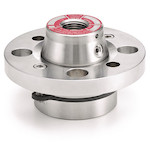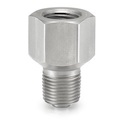 |
| Process pressure gauge. (Ashcroft) |
While there are millions of possible combinations of shapes, sizes, options and materials, pressure gauges all share the five following application criteria, required for safe use and long product life.
 |
| Diaphragm seal. (Ashcroft) |
1 - Process Media Properties: Media that is corrosive, sludgy, or that can solidify is a potential problem for pressure gauges. In non-corrosive, non-clogging media applications, a direct connection without intermediate protection can be applied. For process media that could potentially clog or chemically affect the gauge's wetted parts, a diaphragm seal should be used.
2 - Process Media Temperature: Very hot media, such as steam or hot water, can elevate the gauge's internal temperature leading to failure or an unsafe condition. For high temperature applications, the use of a "pigtail siphon" or diaphragm seal is recommended. Siphons act as a heat sink and lower the exposure temperature. Diaphragm seals isolate the gauge from the higher temperatures.
 |
| Pigtail siphon. |
 |
| Snubber |
5 - Mounting: Pressure gauges are standardly available with bottom (radial) and back connections. NPT (National Pipe Thread Taper) threaded connections are generally the standard. Many other process connections are available though, such as straight threads, metric threads, and specialized fittings. Make sure you know how the gauge is being connected. When mounting, pressure gauges should be almost always be mounted upright.
For more information about pressure gauges, contact Mead O'Brien by visiting https://meadobrien.com or by calling (800) 892-2769.